Forkhead box transcription factor FOXO3a regulates estrogen receptor alpha expression and is repressed by the Her-2/neu/phosphatidylinositol 3-kinase/Akt signaling pathway
- PMID: 15367686
- PMCID: PMC516736
- DOI: 10.1128/MCB.24.19.8681-8690.2004
Forkhead box transcription factor FOXO3a regulates estrogen receptor alpha expression and is repressed by the Her-2/neu/phosphatidylinositol 3-kinase/Akt signaling pathway
Abstract
The expression status of the estrogen receptor alpha (ERalpha) and that of the epidermal growth factor receptor Her-2/neu frequently correlate inversely in breast cancers. While ERalpha-dependent cancers respond to antiestrogen therapy, Her-2/neu-overexpressing cancers typically display resistance to antiestrogens and poor prognosis. In this report we have explored the mechanism linking the loss of expression of ERalpha in breast cancer cells with overexpression of Her-2/neu, which signals constitutively via a phosphatidylinositol 3-kinase (PI3K)/Akt kinase pathway. We identify for the first time the Forkhead box protein FOXO3a (formerly termed FKHRL-1), which is inactivated by Akt, as a key regulator of ERalpha gene transcription. In breast cancer cell lines, expression of ERalpha was correlated with active FOXO3a levels. Ectopic FOXO3a expression induced ERalpha protein levels and promoter activity, while a dominant negative FOXO3a decreased ERalpha levels. By using transient transfection, mobility shift assays, and site-directed mutagenesis, two major functional Forkhead binding sites were identified in the human ERalpha promoter B. A chromatin immunoprecipitation assay confirmed FOXO3a binding at these two sites. Ectopic FOXO3a induced estrogen response element-driven reporter activity and expression of ERalpha target genes. The constitutively activated myristylated Akt reduced ERalpha expression, whereas agents that negatively affect the PI3K/Akt pathway, i.e., wortmannin, celecoxib, and the green tea polyphenol epigallocatechin-3 gallate, induced ERalpha. Thus, FOXO3a represents an important intracellular mediator of ERalpha expression, suggesting possible therapeutic intervention strategies for Her-2/neu-overexpressing refractory breast tumors.
Figures

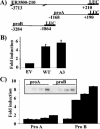
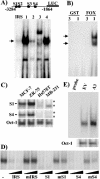
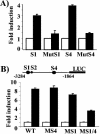
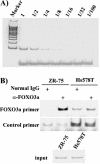
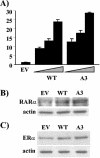
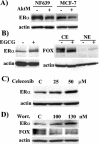
Similar articles
-
Activation of FOXO3a by the green tea polyphenol epigallocatechin-3-gallate induces estrogen receptor alpha expression reversing invasive phenotype of breast cancer cells.Cancer Res. 2007 Jun 15;67(12):5763-70. doi: 10.1158/0008-5472.CAN-06-4327. Cancer Res. 2007. PMID: 17575143
-
AKT3 regulates ErbB2, ErbB3 and estrogen receptor α expression and contributes to endocrine therapy resistance of ErbB2(+) breast tumor cells from Balb-neuT mice.Cell Signal. 2014 May;26(5):1021-9. doi: 10.1016/j.cellsig.2014.01.018. Epub 2014 Jan 24. Cell Signal. 2014. PMID: 24463007
-
Her-2/neu overexpression induces NF-kappaB via a PI3-kinase/Akt pathway involving calpain-mediated degradation of IkappaB-alpha that can be inhibited by the tumor suppressor PTEN.Oncogene. 2001 Mar 15;20(11):1287-99. doi: 10.1038/sj.onc.1204257. Oncogene. 2001. PMID: 11313873
-
ErbB (HER) receptors can abrogate antiestrogen action in human breast cancer by multiple signaling mechanisms.Clin Cancer Res. 2003 Jan;9(1 Pt 2):511S-5S. Clin Cancer Res. 2003. PMID: 12538508 Review.
-
Activating FOXO3a, NF-kappaB and p53 by targeting IKKs: an effective multi-faceted targeting of the tumor-cell phenotype?Cancer Biol Ther. 2004 Jul;3(7):614-6. doi: 10.4161/cbt.3.7.1057. Epub 2004 Jul 24. Cancer Biol Ther. 2004. PMID: 15254408 Review.
Cited by
-
Expression of a phosphorylated p130(Cas) substrate domain attenuates the phosphatidylinositol 3-kinase/Akt survival pathway in tamoxifen resistant breast cancer cells.J Cell Biochem. 2009 May 15;107(2):364-75. doi: 10.1002/jcb.22136. J Cell Biochem. 2009. PMID: 19330798 Free PMC article.
-
HER2: biology, detection, and clinical implications.Arch Pathol Lab Med. 2011 Jan;135(1):55-62. doi: 10.5858/2010-0454-RAR.1. Arch Pathol Lab Med. 2011. PMID: 21204711 Free PMC article. Review.
-
Regulation of the FOXM1 transcription factor by the estrogen receptor alpha at the protein level, in breast cancer.Hippokratia. 2006 Jul;10(3):128-32. Hippokratia. 2006. PMID: 20351808 Free PMC article.
-
The Ras signaling inhibitor LOX-PP interacts with Hsp70 and c-Raf to reduce Erk activation and transformed phenotype of breast cancer cells.Mol Cell Biol. 2011 Jul;31(13):2683-95. doi: 10.1128/MCB.01148-10. Epub 2011 May 2. Mol Cell Biol. 2011. PMID: 21536655 Free PMC article.
-
Biology and therapeutic potential of PI3K signaling in ER+/HER2-negative breast cancer.Breast. 2013 Aug;22 Suppl 2(0 2):S12-8. doi: 10.1016/j.breast.2013.08.001. Epub 2013 Sep 5. Breast. 2013. PMID: 24011769 Free PMC article. Review.
References
-
- Brunet, A., A. Bonni, M. J. Zigmond, M. Z. Lin, P. Juo, L. S. Hu, M. J. Anderson, K. C. Arden, J. Blenis, and M. E. Greenberg. 1999. Akt promotes cell survival by phosphorylating and inhibiting a Forkhead transcription factor. Cell 96:857-868. - PubMed
-
- Brunet, A., G. Pages, and J. Pouyssegur. 1994. Constitutively active mutants of MAP kinase kinase (MEK1) induce growth factor-relaxation and oncogenicity when expressed in fibroblasts. Oncogene 9:3379-3387. - PubMed
-
- Burgess, A. W., H. S. Cho, C. Eigenbrot, K. M. Ferguson, T. P. Garrett, D. J. Leahy, M. A. Lemmon, M. X. Sliwkowski, C. W. Ward, and S. Yokoyama. 2003. An open-and-shut case? Recent insights into the activation of EGF/ErbB receptors. Mol. Cell 12:541-552. - PubMed
Publication types
MeSH terms
Substances
Grants and funding
LinkOut - more resources
Full Text Sources
Other Literature Sources
Research Materials
Miscellaneous
